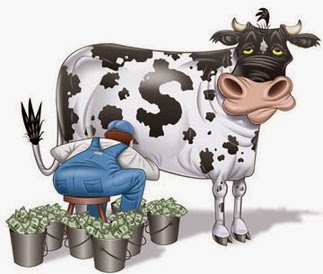First, the girl refused to budge from her paddock. I had to drag and drive her the whole way. I finally got her to my make-shift hand-milking station, and she refused to stay still. She moved forwards, then backwards, then sideways, then forwards, and so on. I barely got any milk out of her. She paused for maybe a minute to munch some hay, then starting throwing her little tantrum again.
So, I brought her back to the paddock (with all kinds of pulling, prodding, and poking) and took care of some other chores for about 15 minutes. I tried again from the top. Same story.
I put her (most unwillingly) back in the paddock again. Then I did some more chores until I was just about done.I tried one last time. She stood a bit more still, but wouldn't let down. I got her to stand still for about 5 minutes, but she dried herself up completely. Since Tuesday's haul of our first milk, this was our worst milk day. By a lot.
Wife told me that Bridget won. I knew it, but I didn't want to admit it. But Wife is always right.
 |
| Misbehaved and still got her calf back. Yup. I lost today. |
She's certainly gotten used to our little routine of me milking for a bit, then her being reunited to her baby for him to clear her out. She's humoring me at best, and battling wills (and winning) at worst.
So yes - big setback this morning.
As I stewed at my desk for a few hours, I came to gradually realize that this is an opportunity for personal growth. Our priest this past week said that we should thank God when there is a person who drives us absolutely nuts in our lives, as that person will help make us holy. He even talked about how St. Benedict encouraged abbots to find such a person, one who drove the entire monastic community batty, specifically to make the community holier.
Bridget must be sanctifying me like gangbusters right now. I guess St. Brigid of Kildare is really praying for me.
So, this setback is definitely an opportunity to grow. I can grow in patience, grow in perseverance, grow in discipline, and grow in general holiness through adversity. This will be a good thing for me. I need to redouble my efforts in training her, evaluate myself critically at what I can do better, and take action.
This a really good thing, because I think in all the bovine craziness that's swept the homestead, I've forgotten my main goals for the year:
Seek ye therefore first the kingdom of God, and his justice, and all these things shall be added unto you. –Matthew 6:33
Ultimately, Bridget will need to be trained to a new routine, and in just over a week's time, Brisket will be weaned cold-turkey. Until that happens, I need to reassert myself as "alpha" while at the same time not losing sight of the target.
And for me, the target is growing holier while and through homesteading.



















